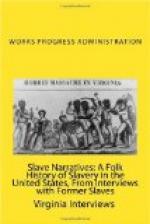At the end of the war, the South was placed under military rule. The presence of the Yankee guardsmen had a psychological effect upon the Southerners and they were very humble.
Before the terrors of the war had subsided a new menace sprang up—the Klu Klux Klan. While its energy was usually directed against ex-slaves, a white man was sometimes a victim. One such occasion was recalled by Clay. The group planned to visit a man who for some reason became suspicious and prepared to outwit them if they came. He heated a huge pot of water and when a part of his door was crashed in he reached through the opening and poured gourds of boiling water upon his assailants. They retreated, [HW: and] while they were away, he made his way to Atlanta.
Another group which began its operations shortly after the close of the war was a military clan organized for the purpose of giving the ex-slaves a knowledge of drilling and war tactics. An order to disband was received from the “Black Horse Calvary” by the leader of the group. His life was threatened when he failed to obey so he prepared for a surprise visit. He fortified his house with twenty-five men on the inside and the same number outside. When the approaching calvarymen reached a certain point, the fifty hidden men fired at the same time. Seven members of the band were killed and many others wounded. There was no further interference from this group.
Clay and his father ran a grocery store just after Emancipation. He did not like this type of work and apprenticed himself to a painter to learn the trade. He is still considered an excellent painter though he does not receive much work.
He has always taken care of himself and never “ran about” at night. He boasts that his associates never included a dancing woman. As he has used tobacco for sixty-five years, he does not consider it a menace to health but states that worry will kill anyone and the man who wants to live a long time must form the habit of not worrying. His Indian blood—the high cheek bones, red skin and straight black hair now tinged with grey make this unmistakable—has probably played a large part in the length of his life.
[HW: Dist. 7
Ex-Slave #22]
Adella S. Dixon
District 7
Pierce Cody
old slave story
[HW: About 88]
[may 8 1937]
Pierce Cody was the eldest son of Elbert and Dorothy Cody. His father was born in Richmond, Virginia, his mother in Warren County. When the Emancipation Proclamation was signed, he, the eldest child in a large family, was in his early teens. This group lived on the place owned by Mr. Bob Cody, [HW: whose] family was a group of ardent believers in the Hardshell Baptist faith. So firm was their faith that a church of this denomination was provided for the slaves and each one required to become a member. A white minister invariably preached the then worn out doctrine of a slave’s duty to his master, the reward of faithfulness and the usual admonition against stealing.




